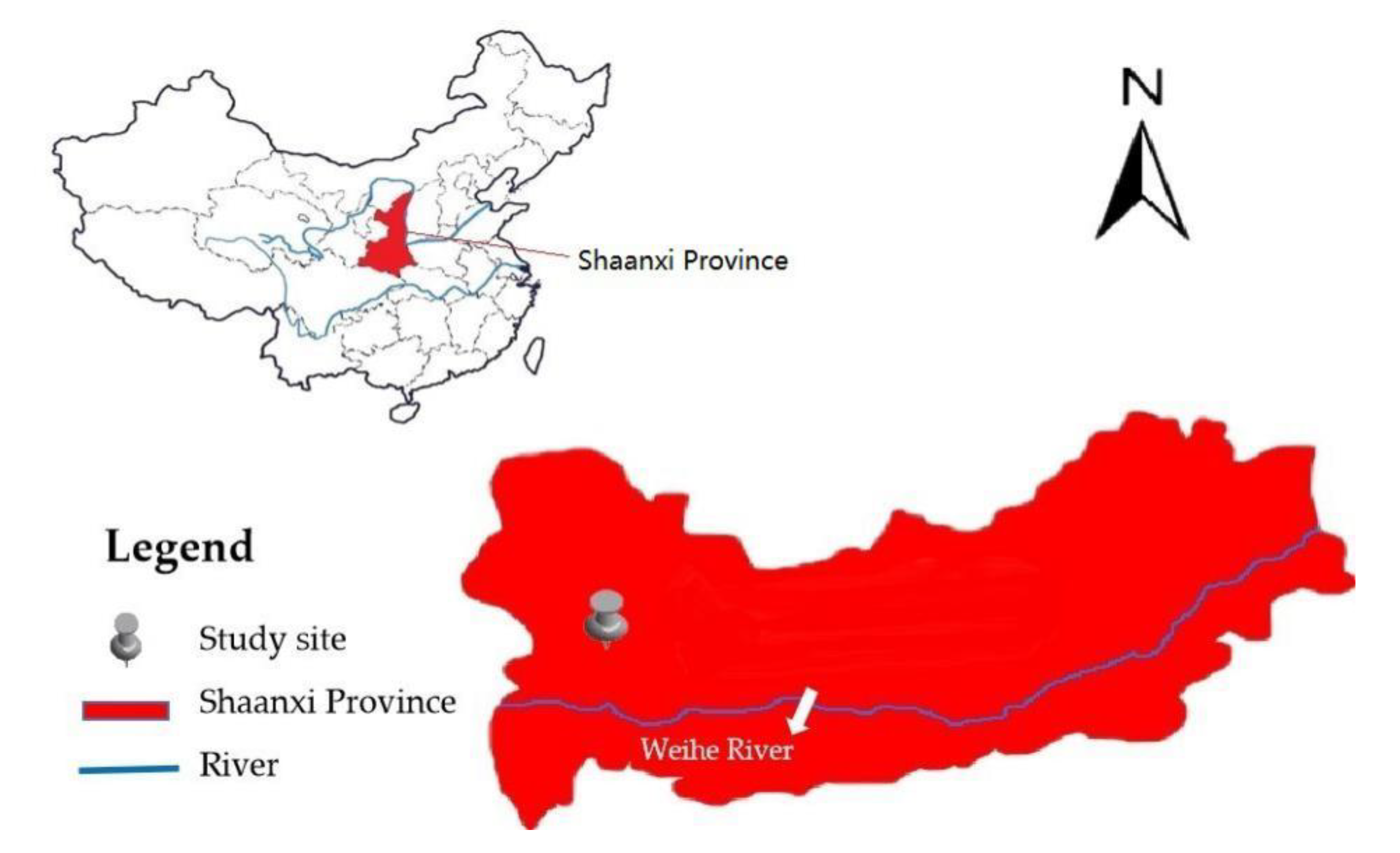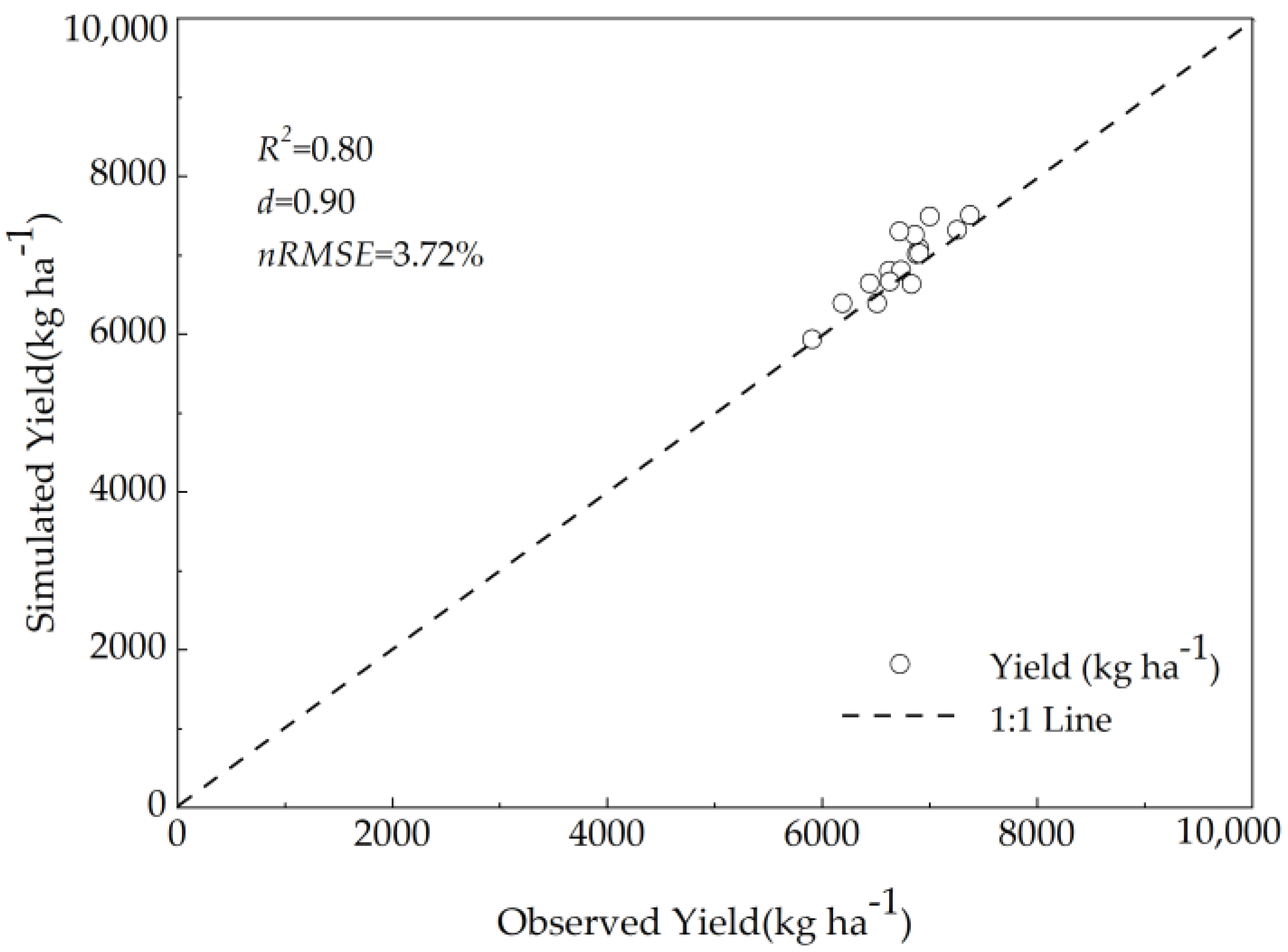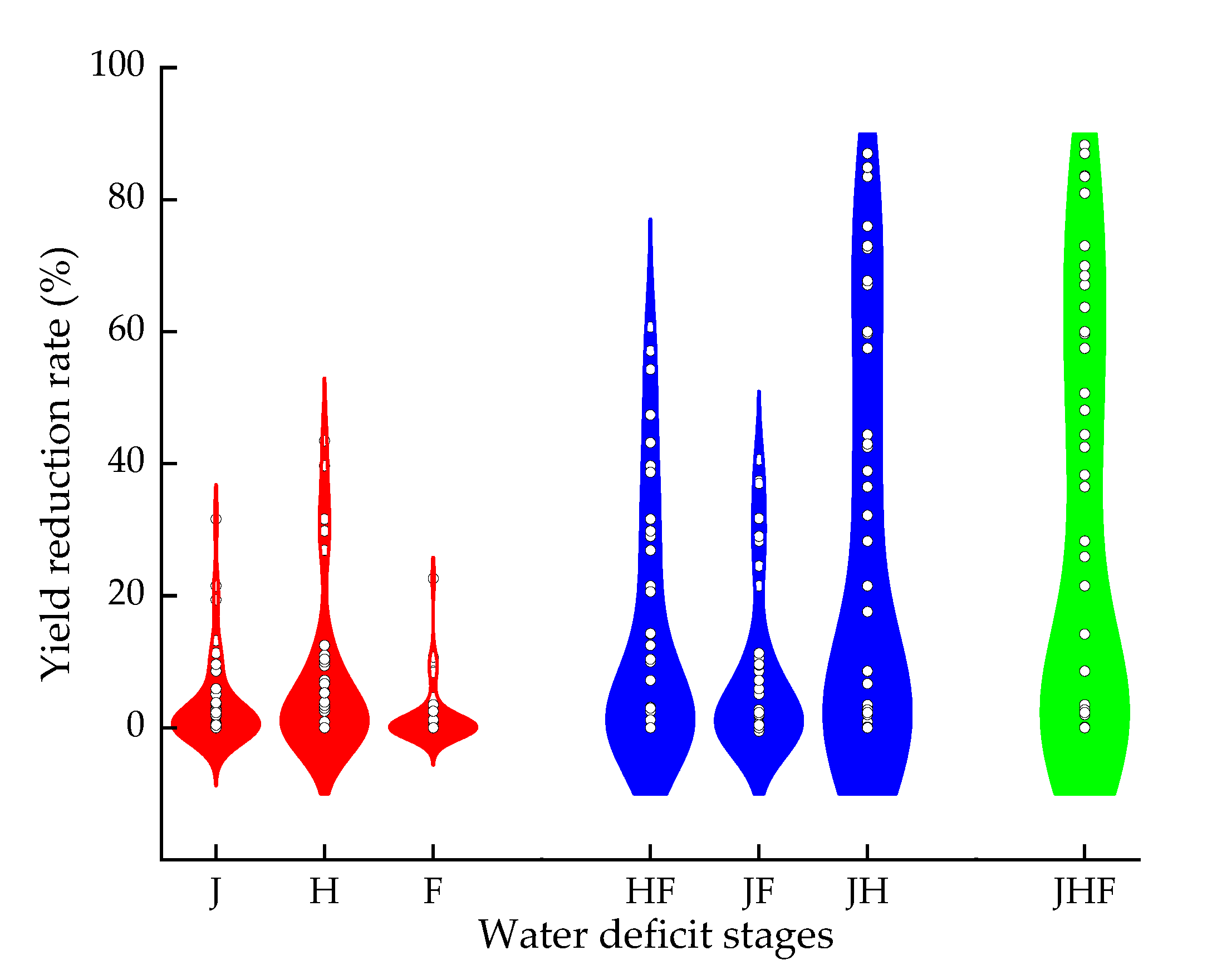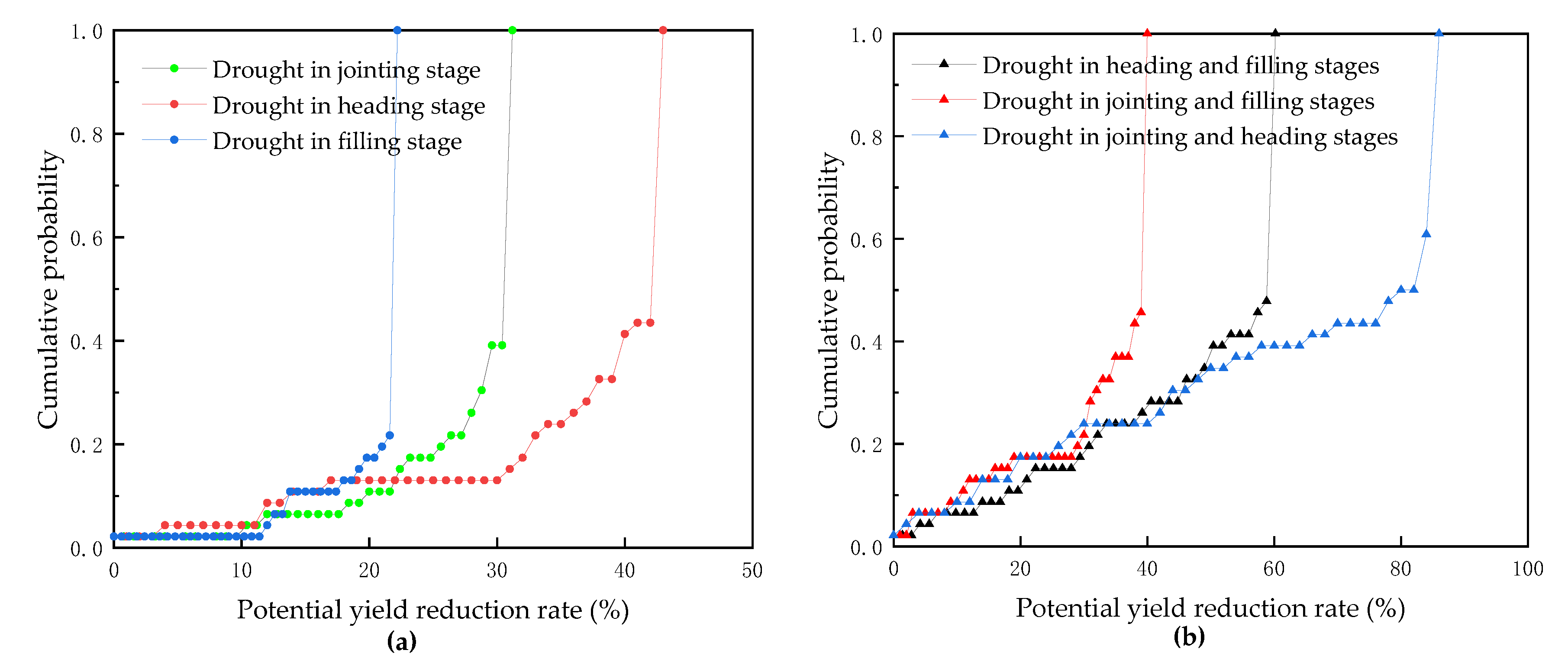Evaluation of the Potential Effects of Drought on Summer Maize Yield in the Western Guanzhong Plain, China
Abstract
:1. Introduction
2. Materials and Methods
2.1. Study Site
2.2. Field Experiments
2.3. Description of DSSAT-Maize Model
2.3.1. Meteorological Data
2.3.2. Soil Data
2.3.3. Crop Variety Genetic Parameters
2.4. Model Evaluation
2.5. Summer Maize Drought Loss Setting
3. Results
3.1. DSSAT Model Calibration
3.2. DSSAT Model Evaluation
3.3. Varieties of Potential Yield Reduction
3.3.1. Effective Precipitation of Summer Maize (1970–2015) at Wugong County
3.3.2. Potential Yield Reduction of Summer Maize from 1970 to 2015
3.3.3. Potential Yield Reduction during Different Growth Stages of Summer Maize
3.4. Cumulative Probability of Potential Yield Reduction
4. Discussion
5. Conclusions
Author Contributions
Funding
Conflicts of Interest
References
- Tao, F.; Yokozawa, M.; Zhang, Z. Modelling the impacts of weather and climate variability on crop productivity over a large area: A new process-based model development, optimization, and uncertainties analysis. Agric. For. Meteorol. 2009, 149, 831–850. [Google Scholar] [CrossRef]
- Xiong, W.; Holman, I.; Lin, E.; Conway, D.; Jiang, J.; Xu, Y.; Li, Y. Climate change, water availability and future cereal production in China. Agric. Ecosyst. Environ. 2010, 135, 58–69. [Google Scholar] [CrossRef]
- Lobell, D.B.; Schlenker, W.; Costa-Roberts, J. Climate trends and global crop production since 1980. Science 2011, 333, 616–620. [Google Scholar] [CrossRef] [PubMed] [Green Version]
- Ju, H.; Lin, E.D.; Wheeler, T.; Challinor, A.; Jiang, S. Climate change modelling and its roles to Chinese crops yield. J. Integr. Agric. 2013, 12, 892–902. [Google Scholar] [CrossRef]
- Sheffield, J.; Wood, E.F.; Chaney, N.; Guan, K.; Sadri, S.; Yuan, X.; Olang, L.; Amani, A.; Ali, A.; Demuth, S.; et al. A drought monitoring and forecasting system for Sub-Sahara African water resources and food security. Bull. Am. Meteorol. Soc. 2014, 95, 861–882. [Google Scholar] [CrossRef]
- Lesk, C.; Rowhani, P.; Ramankutty, N. Influence of extreme weather disasters on global crop production. Nature 2016, 529, 84–87. [Google Scholar] [CrossRef]
- Chen, J.Z.; Lin, L.R.; Lü, G. An index of soil drought intensity and degree: An application on corn and a comparison with CWSI. Agric. Water Manag. 2010, 97, 865–871. [Google Scholar] [CrossRef]
- Esfahanian, E.; Nejadhashemi, A.P.; Abouali, M.; Adhikari, U.; Zhang, Z.; Daneshvar, F.; Herman, M.R. Development and evaluation of a comprehensive drought index. J. Environ. Manag. 2017, 185, 31–43. [Google Scholar] [CrossRef] [Green Version]
- Guan, Y.H.; Zheng, F.L.; Zhang, P.; Qin, C. Spatial and temporal changes of meteorological disasters in China during 1950–2013. Nat. Hazards 2014, 75, 2607–2623. [Google Scholar] [CrossRef]
- Murthy, C.S.; Laxman, B.; Sesha Sai, M.V.R. Geospatial analysis of agricultural drought vulnerability using a composite index based on exposure, sensitivity and adaptive capacity. Int. J. Disaster Risk Reduct. 2015, 12, 163–171. [Google Scholar] [CrossRef]
- Liu, X.F.; Zhu, X.F.; Pan, Y.Z.; Li, S.; Liu, Y.; Ma, Y. Agricultural drought monitoring: Progress, challenges, and prospects. J. Geogr. Sci. 2016, 26, 750–767. [Google Scholar] [CrossRef] [Green Version]
- Gupta, A.; Rico-Medina, A.; Caño-Delgado, A. The physiology of plant responses to drought. Science 2020, 368, 266–269. [Google Scholar] [CrossRef] [PubMed]
- Rhee, J.; Im, J.; Carbone, G.J. Monitoring agricultural drought for arid and humid regions using multi-sensor remote sensing data. Remote Sens. Environ. 2010, 114, 2875–2887. [Google Scholar] [CrossRef]
- Anderson, M.C.; Zolin, C.A.; Sentelhas, P.C.; Hain, C.R.; Semmens, K.; Tugrul Yilmaz, M.; Gao, F.; Otkin, J.A.; Tetrault, R. The evaporative stress index as an indicator of agricultural drought in Brazil: An assessment based on crop yield impacts. Remote Sens. Environ. 2016, 174, 82–99. [Google Scholar] [CrossRef]
- Chen, T.; Xia, G.; Liu, T.; Chen, W.; Chi, D. Assessment of drought impact on main cereal crops using a standardized precipitation evapotranspiration index in Liaoning Province, China. Sustainability 2016, 8, 1069. [Google Scholar] [CrossRef] [Green Version]
- Gadge, S.B.; Gorantiwar, S.D.; Kumar, V.; Kothari, M. Estimation of crop water requirement based on penman-monteith approach under micro-irrgation system. J. Agrometeorol. 2011, 13, 58–61. [Google Scholar]
- Leng, G.Y.; Tang, Q.H.; Rayburg, S. Climate change impacts on meteorological, agricultural and hydrological droughts in China. Glob. Planet. Chang. 2015, 126, 23–34. [Google Scholar] [CrossRef]
- Potopová, V.; Boroneanţ, C.; Boincean, B.; Soukup, J. Impact of agricultural drought on main crop yields in the Republic of Moldova. Int. J. Climatol. 2016, 36, 2063–2082. [Google Scholar] [CrossRef] [Green Version]
- Pascoa, P.; Gouveia, C.M.; Russo, A.; Trigo, R.M. The role of drought on wheat yield inter annual variability in the Iberian Peninsula from 1929 to 2012. Int. J. Biometeorol. 2017, 61, 439–451. [Google Scholar] [CrossRef]
- XUE, C.Y.; MA, Z.H.; HU, C.D. Spatiotemporal characteristics of drought during summer maize growing season in Huang-Huai-Hai area for recent 40 years. J. Nat. Disasters 2016, 25, 1–14. [Google Scholar]
- Gao, C.; Li, X.; Sun, Y.; Zhou, T.; Luo, G.; Chen, C. Water requirement of summer maize at different growth stages and the spatiotemporal characteristics of agricultural drought in the Huaihe River Basin, China. Theor. Appl. Climatol. 2018, 136, 1289–1302. [Google Scholar] [CrossRef]
- Potopová, V.; Trnka, M.; Hamouz, P.; Soukup, J.; Castraveț, T. Statistical modelling of drought-related yield losses using soil moisture-vegetation remote sensing and multiscalar indices in the south-eastern Europe. Agric. Water Manag. 2020, 236, 106168. [Google Scholar] [CrossRef]
- Wang, Y.; Zhao, W.; Zhang, Q.; Yao, Y.B. Characteristics of drought vulnerability for maize in the eastern part of Northwest China. Sci. Rep. 2019, 9, 964. [Google Scholar] [CrossRef] [Green Version]
- Shiau, J.T. Effects of Gamma-Distribution variations on SPI-Based stationary and nonstationary drought analyses. Water Resour. Manag. 2020, 34, 2081–2095. [Google Scholar] [CrossRef]
- Jones, J.W.; Hoogenboom, G.; Porter, C.H.; Boote, K.J.; Batchelor, W.D.; Hunt, L.A.; Wilkens, P.W.; Singh, U.; Gijsman, A.J.; Ritchie, J.T. The DSSAT cropping system model. Eur. J. Agron. 2003, 18, 235–265. [Google Scholar] [CrossRef]
- Jiang, Y.; Zhang, L.; Zhang, B.; He, C.; Jin, X.; Bai, X. Modeling irrigation management for water conservation by DSSAT-maize model in arid northwestern China. Agric. Water Manag. 2016, 177, 37–45. [Google Scholar] [CrossRef]
- Bai, L.P.; Sui, F.G.; Sun, Z.H.; Ge, T.D.; Lv, Y.Y.; Zhou, G.S. Effects of soil water stress on morphological development and yield of maize. Acta Ecol. Sin. 2004, 24, 1556–1560. [Google Scholar]
- Igbadun, H.E.; Salim, B.A.; Tarimo, A.K.P.R.; Mahoo, H.F. Effects of deficit irrigation scheduling on yields and soil water balance of irrigated maize. Irrig. Sci. 2008, 27, 11–23. [Google Scholar] [CrossRef]
- Chen, C.X.; Dong, Z.Q.; Xu, T.J.; Gao, J.; Jiao, l.; Lu, L.; Zhang, F.L. Effects of PASP-KT-NAA on the photosynthetic performances of different maize cultivar in different accumulated temperature zones. J. Maize Sci. 2013, 3, 71–75. [Google Scholar]
- Geng, S.; Yan, D.; Yang, Z.; Zhang, Z.; Yang, M.; Kan, G. Characteristics analysis of summer maize yield loss caused by drought stress in the Northern Huaihe Plain, China. Irrig. Drain. 2018, 67, 251–268. [Google Scholar] [CrossRef]
- Hu, Y.N.; Liu, Y.J.; Tang, H.J.; Xu, Y.L.; Pan, J. Contribution of drought to potential crop yield reduction in a wheat-maize rotation region in the North China Plain. J. Integr. Agric. 2014, 13, 1509–1519. [Google Scholar] [CrossRef]
- Saddique, Q.; Cai, H.; Ishaque, W.; Chen, H.; Chau, H.; Chattha, M.; Hassan, M.; Khan, M.; He, J. Optimizing the sowing date and irrigation strategy to improve maize yield by using CERES (Crop Estimation through Resource and Environment Synthesis)-maize model. Agronomy 2019, 9, 109. [Google Scholar] [CrossRef] [Green Version]
- Xu, J.W.; Ju, H.; Mei, X.R.; Liu, Q.; Yang, J.Y. Simulation on potential effects of drought on winter wheat in Huang-Huai-Hai Plain from 1981 to 2010. Trans. Chin. Soc. Agric. Eng. 2015, 31, 150–158. [Google Scholar]
- Zhang, Q.; Zhang, C.J.; Bai, H.Z.; Li, L.; Sun, L.D.; Liu, D.X.; Wang, J.S.; Zhao, H.Y. New development of climate change in Northwest China and its impact on arid environment. J. Arid Meteorol. 2010, 28, 1–7. [Google Scholar]
- Shi, Y.F.; Shen, Y.P.; Hu, R.J. Preliminary study on signal, impact and foreground of climatic shif from warm-dry to warm-humid in Northwest China. J. Glaciol. Geocryol. 2002, 24, 219–226. [Google Scholar]
- Angstrom, A. Solar and terrestrial radiation: Report to the international commission for solar research on actinometric investigations of solar and atmospheric radiation. Q. J. R. Meteorol. Soc. 1924, 50, 121–126. [Google Scholar] [CrossRef]
- Briggs, L.J.; Mclane, J.W. The Moisture Equivalents of Soils; Bureau of Soils Bulletin No. 45; U.S. Department of Agriculture: Washington, DC, USA, 1907.
- Wu, T.N.; Wang, Y.Q.; Lv, J.W.; Zhang, B. Soil water characteristics of middle pleistocene paleosol layers on the loess plateau. Afr. J. Biotechnol. 2011, 10, 10856–10863. [Google Scholar]
- Rahardjo, H.; Satyanaga, A.; D’Amore, G.; Leong, E.C. Soil-water characteristic curves of gap-graded soils. Eng. Geol. 2012, 125, 102–107. [Google Scholar] [CrossRef]
- Willmott, C.J. On the validation of models. Phys. Geogr. 1981, 2, 184–194. [Google Scholar] [CrossRef]
- Anothai, J.; Soler, C.; Green, A.; Trout, T.; Hoogenboom, G. Evaluation of two evapotranspiration approaches simulated with the CSM–CERES–Maize model under different irrigation strategies and the impact on maize growth, development and soil moisture content for semi-arid conditions. Agric. For. Meteorol. 2013, 176, 64–76. [Google Scholar] [CrossRef]
- Liang, W.Q.; Cai, H.J.; Wang, J. Experiment study on crop coefficient of maize in Guanzhong region of Shaanxi Province. Water Sav. Irrig. 2011, 12, 5–8. [Google Scholar]
- FAO. Crop Evapotranspitation—Guidelines for Computing Crop Water Requirements—FAO Irrigation and Drainage Paper 56; Food and Agriculture Organization of the United Nations: Rome, Italy, 1998. [Google Scholar]
- Wang, Z.N. Irrigation and Drainage Engineering, 2nd ed.; Agricultural Press: Beijing, China, 2000; p. 39. [Google Scholar]
- Savitzky, A.; Golay, M.J.E. Smoothing and differentiation of data by simplified least squares procedures. Anal. Chem. 1964, 36, 1627–1639. [Google Scholar] [CrossRef]
- Xu, Z.; Zhou, G.; Shimizu, H. Plant responses to drought and rewatering. Plant Signal. Behav. 2014, 5, 649–654. [Google Scholar] [CrossRef] [PubMed] [Green Version]
- Akir, R. Effect of water stress at different development stages on vegetative and reproductive growth of corn. Field Crops Res. 2004, 89, 1–16. [Google Scholar]
- Hirich, A.; Ragab, R.; Choukr-Allah, R.; Rami, A. The effect of deficit irrigation with treated wastewater on sweet corn: Experimental and modelling study using SALTMED model. Irrig. Sci. 2014, 32, 205–219. [Google Scholar] [CrossRef]
- Jin, N.; He, J.Q.; Fang, Q.X.; Chen, C.; Ren, Q.F.; He, L.; Yao, N.; Song, L.B.; Yu, Q. The Responses of maize yield and water use to growth stage-based irrigation on the Loess Plateau in China. Int. J. Plant Prod. 2020, 14, 1–13. [Google Scholar] [CrossRef]
- Mokany, K.; Raison, R.J.; Prokushkin, A.S. Critical analysis of root: Shoot ratios in terrestrial biomes. Glob. Chang. Biol. 2006, 12, 84–96. [Google Scholar] [CrossRef]
- Bu, L.D.; Zhang, R.H.; Han, M.M.; Xue, J.Q.; Chang, Y. The physiological mechanism of compensation effect in maize leaf by re-watering after drought stress. Acta Agric. Boreali-Occident. Sin. 2009, 18, 88–92. [Google Scholar]
- Cai, F.; Ming, H.Q.; Xie, Y.B.; Mi, N.; Zhao, X.L.; Zhang, Y.S. Effect of drought stress on root growth during the key growth periods of spring maize in Northeast China. J. Meteorol. Environ. 2018, 34, 75–81. [Google Scholar]
- Zhang, J.P.; He, Y.K.; Wang, J.; Zhao, Y.X.; Wang, C.Y. Impact simulation of drought at different growth stages on grain formation and yield of maize. Chin. J. Agrometeorol. 2015, 36, 43–49. [Google Scholar]
- Liu, Y.L.; Guo, X.S.; Ma, M.S. Effects of drought stress and rewatering at seedling stage on light energy utilization and antioxidant enzymes activities of spring maize leaves. J. Soil Water Conserv. 2018, 32, 339–343. [Google Scholar]
- Liu, S.; Wang, Y.; Miao, Q.L.; Ding, Y.Y. Variation characteristics of thermal resources in Northeast China in recent 50 years. J. Appl. Meteorol. Sci. 2010, 21, 266–278. [Google Scholar]
- Yu, W.Y.; Ji, R.P.; Feng, R.; Zhao, X.L.; Zhang, Y.S. Response of water stress on photosynthetic characteristics and water use efficiency of maize leaves in different growth stage. Acta Ecol. Sin. 2015, 35, 2902–2909. [Google Scholar]










| Soil Layer (cm) | Silt (%) | Clay (%) | Bulk Density (g cm−3) | Saturation Water Content (cm3 cm−3) | Field Capacity (cm3 cm−3) | Permanent Wilting Point (cm3 cm−3) |
| 0–20 | 41.4 | 28.2 | 1.32 | 0.435 | 0.306 | 0.162 |
| 20–40 | 41.8 | 27.4 | 1.58 | 0.439 | 0.317 | 0.173 |
| 40–60 | 42.2 | 29.2 | 1.62 | 0.440 | 0.319 | 0.173 |
| 60–80 | 39.7 | 28.1 | 1.61 | 0.440 | 0.322 | 0.179 |
| 80–100 | 41.8 | 29.6 | 1.57 | 0.443 | 0.325 | 0.179 |
| Soil Layer (cm) | Soil Organic Carbon (%) | PH | Ammonium Nitrogen (mg L−1) | Nitrate (mg L−1) | ||
| 0–20 | 0.90 | 8.0 | 2.19 | 0.98 | ||
| 20–40 | 1.03 | 8.1 | 3.89 | 0.90 | ||
| 40–60 | 0.92 | 7.8 | 3.30 | 1.20 | ||
| 60–80 | 0.98 | 8.3 | 3.25 | 1.09 | ||
| 80–100 | 1.01 | 8.5 | 3.15 | 0.85 | ||
| Parameters | Description | Range |
|---|---|---|
| P1 (°C day) | Degree days (based 8 °C) from seedling emergence to the end of the juvenile | 100 ~ 400 |
| P2 (day) | Photoperiod sensitivity coefficient | 0 ~ 4 |
| P5 (°C day) | Degree days (based 8 °C) from silking to physiological maturity | 600 ~ 1000 |
| G2 (Kernel) | Maximum possible number of kernels per plant | 500 ~ 1000 |
| G3 (mg kernel−1 day−1) | Potential kernel growth rate | 5 ~ 12 |
| PHINT (°C day) | Degree days required for a leaf tip to emerge | 30 ~ 75 |
| Treatment | Irrigation Amount at Jointing Stage/mm | Irrigation Amount at Heading Stage/mm | Irrigation Amount at Filling Stage/mm |
|---|---|---|---|
| CK | WD1 | WD2 | WD3 |
| T1 | 0 | WD2 | WD3 |
| T2 | WD1 | 0 | WD3 |
| T3 | WD1 | WD2 | 0 |
| T4 | WD1 | 0 | 0 |
| T5 | 0 | WD2 | 0 |
| T6 | 0 | 0 | WD3 |
| T7 | 0 | 0 | 0 |
| Variety | P1 | P2 | P5 | G2 | G3 | PHINT |
|---|---|---|---|---|---|---|
| Zhengdan 958 | 335 | 0.52 | 755 | 554 | 10.7 | 37.7 |
| Growth Stages | Measured | Simulated | nRMSE (%) |
|---|---|---|---|
| Emergence (days after planting) | 6 | 5 | 16.67 |
| Jointing (days after planting) | 39 | 41 | 5.13 |
| Anthesis (days after planting) | 60 | 63 | 5.00 |
| End of grain filling (days after planting) | 110 | 113 | 2.73 |
| Harvest (days after planting) | 116 | 117 | 0.86 |
© 2020 by the authors. Licensee MDPI, Basel, Switzerland. This article is an open access article distributed under the terms and conditions of the Creative Commons Attribution (CC BY) license (http://creativecommons.org/licenses/by/4.0/).
Share and Cite
Shen, H.; Chen, Y.; Wang, Y.; Xing, X.; Ma, X. Evaluation of the Potential Effects of Drought on Summer Maize Yield in the Western Guanzhong Plain, China. Agronomy 2020, 10, 1095. https://doi.org/10.3390/agronomy10081095
Shen H, Chen Y, Wang Y, Xing X, Ma X. Evaluation of the Potential Effects of Drought on Summer Maize Yield in the Western Guanzhong Plain, China. Agronomy. 2020; 10(8):1095. https://doi.org/10.3390/agronomy10081095
Chicago/Turabian StyleShen, Hongzheng, Yizheng Chen, Yongqiang Wang, Xuguang Xing, and Xiaoyi Ma. 2020. "Evaluation of the Potential Effects of Drought on Summer Maize Yield in the Western Guanzhong Plain, China" Agronomy 10, no. 8: 1095. https://doi.org/10.3390/agronomy10081095
APA StyleShen, H., Chen, Y., Wang, Y., Xing, X., & Ma, X. (2020). Evaluation of the Potential Effects of Drought on Summer Maize Yield in the Western Guanzhong Plain, China. Agronomy, 10(8), 1095. https://doi.org/10.3390/agronomy10081095





